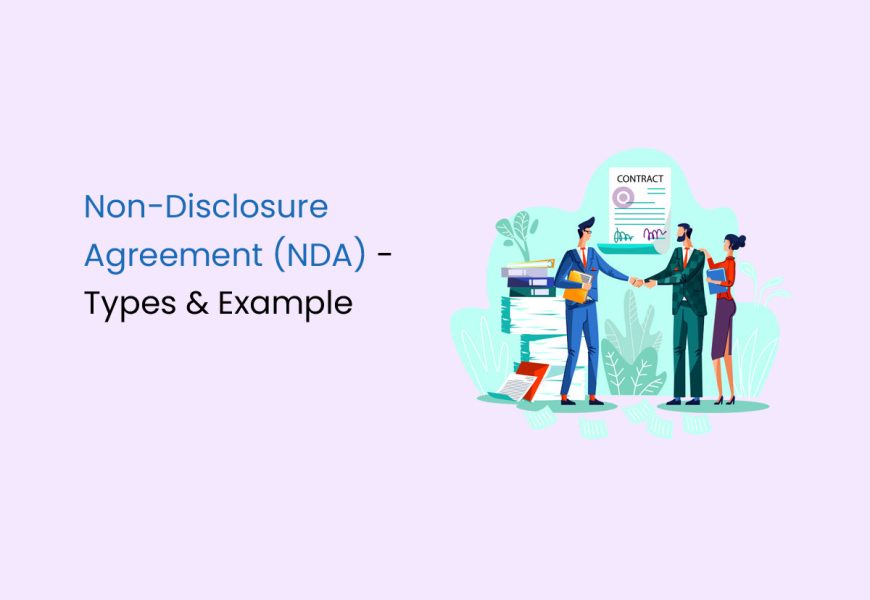A non-disclosure agreement (NDA) is a legally binding contract that facilitates a confidential relationship between two parties. One party holds sensitive information, while the other receives it under the agreement. The recipient commits to maintaining the confidentiality of the information and refrains from disclosing it to third parties. Often interchangeably termed a confidentiality agreement, an NDA is a crucial tool in safeguarding proprietary data.
Businesses frequently utilize NDAs when engaging in negotiations with other entities. These agreements offer a secure framework for sharing sensitive information, assuring both parties that their proprietary data remains protected from falling into the hands of competitors. In scenarios where both parties disclose sensitive information, it’s known as a mutual non-disclosure agreement (MNDA).
Now, let’s delve deeper into the significance and nuances of non-disclosure agreements.
What is a Non-Disclosure Agreement?
Non-disclosure agreements (NDAs) serve as legally enforceable contracts, establishing a confidential bond between parties wherein one possesses sensitive information while the other gains access to it. This confidentiality entails a responsibility for both parties to refrain from sharing the information provided.
Referred to interchangeably as confidentiality agreements, confidentiality disclosure agreements, or non-disclosure contracts, NDAs play a pivotal role in safeguarding sensitive data in various contexts. Whether at the onset of a business relationship or during significant financial transactions, NDAs ensure the protection of proprietary information. For instance, an employer or client may require new hires or contractors to sign NDAs to shield the organisation’s sensitive data.
Unlike other business contracts such as service or sales agreements that delineate terms and conditions of service or transactions, NDAs specifically focus on preserving an individual’s or organization’s information privacy.
What is the Importance of a Non-Disclosure Agreement?
The purpose of a non-disclosure agreement (NDA) is dual-fold, encompassing confidentiality and protection. Within the scope of a confidentiality agreement, a wide array of information is safeguarded, ranging from product specifications to client databases. Business models, test results, and even embargoed press releases or product reviews can all fall under the purview of an NDA.
An NDA establishes a legal framework to shield ideas and information from theft or dissemination to competitors or other third parties. Breaching an NDA entails significant legal consequences, including potential lawsuits, financial penalties, and in severe cases, criminal charges. NDAs provide a crucial layer of defence for businesses, ensuring that inadvertent breaches are also covered.
There are three fundamental functions of an NDA:
- Identifying protected information: NDAs delineate what information is confidential and what can be shared, creating clear boundaries within which parties can operate freely.
- Protecting sensitive information: Signing an NDA imposes a legal obligation to maintain the confidentiality of sensitive information. Any unauthorised disclosure constitutes a breach of contract.
- Safeguarding patent rights: As public disclosure of a pending invention can sometimes jeopardize patent rights, an NDA serves to shield inventors as they develop new products or concepts.
Types of NDA
Mutual Agreement
In scenarios where two businesses are exploring potential partnerships, both parties may engage in strategic discussions, sharing operational insights to better understand each other’s capabilities. In such instances, a mutual non-disclosure agreement (NDA) is typically employed. Under this arrangement, both companies agree not to disclose sensitive information, as each side may receive proprietary details from the other.
Non-Mutual Agreement
Conversely, a non-mutual NDA, also known as a unilateral agreement, is commonly utilised in situations involving new employees who gain access to sensitive company information. In such cases, only the employee is bound by the agreement to maintain confidentiality, as they are the sole recipients of confidential data.
Disclosure Agreement
With the evolving landscape of privacy concerns, there is a growing need for disclosure agreements. For instance, a doctor might require a patient to sign an agreement allowing the sharing of medical information with an insurer. This grants one party the authority to share personal data while safeguarding them from potential legal repercussions.
It’s crucial to recognise that NDAs are legally binding contracts, and any breach of their terms can result in significant legal penalties. Therefore, adherence to the terms of an NDA is imperative to maintain trust and integrity in business relationships.
Example of a Non-Disclosure Agreement
Apple, renowned for its stringent confidentiality practices, operates with utmost secrecy surrounding its technology and upcoming products. This approach serves a dual purpose: safeguarding trade secrets from potential theft by competitors and leveraging anticipation as a marketing strategy.
In a CNBC article dated January 2021, Hyundai confirmed the engagement in discussions with Apple concerning automotive matters, sparking speculation about Apple’s potential foray into the automotive industry or related product development. Following initial statements, Hyundai retracted any explicit mention of Apple from subsequent communications.
Maintaining its characteristic veil of secrecy, Apple mandates all partners to sign non-disclosure agreements (NDAs). Partners are explicitly instructed not to reference “Apple” in any context, with Apple’s legal team issuing stern warnings of substantial monetary repercussions for any information leaks.
(Source: CNBC. “Doing Business with Apple Means You Probably Can’t Tell Anyone About It, As Hyundai Learned.”)
What Do You Need For an NDA?
Requirements for an NDA typically encompass six key elements essential for clarity and enforceability:
Participants in the Agreement
Every NDA must clearly identify the parties involved. This includes specifying the individual or entity disclosing sensitive information and the recipient(s) who will access the information. For instance, the recipient could be a specific individual, all employees of a particular company, or any authorised representatives.
It’s equally vital for the disclosing party, typically a company, to accurately define its identity within the NDA. This is particularly crucial for organisations with complex legal structures. Proper identification ensures that the correct legal entity is acknowledged as the owner of the confidential information. In some cases, a company may need to list multiple legal entities under a broader ownership umbrella to ensure comprehensive coverage.
Definition of Confidential Information
One of the crucial components of an NDA is the clear definition of what constitutes confidential information. This aspect can often pose challenges, as it requires the disclosing party to explicitly identify the information that must remain protected from disclosure. It’s imperative for companies to understand that assumptions about what constitutes proprietary information may not suffice, and it’s their responsibility to specify such details.
Defining confidential information without inadvertently disclosing it within the NDA itself can be a delicate process. To navigate this, companies may opt for broader categorisations of confidentiality. For instance, a company might designate all information originating from or related to its research and development department as confidential.
Exclusions of Confidentiality
In certain scenarios, it may be practical to define what does not fall under the purview of confidentiality. These exclusions serve to delineate specific items that are exempt from the confidentiality obligations outlined in the agreement. By doing so, the company can ensure that certain types of information, which it deems non-sensitive, are not inadvertently treated as confidential.
These aspects of an NDA, namely the definition of confidential information and the exclusions thereof, are critical for establishing clear parameters regarding the protection of proprietary data and fostering trust in business relationships.
Information Protected With an NDA
Non-disclosure agreements (NDAs) serve as valuable tools for safeguarding a wide array of sensitive information within business relationships. While the scope of protection may vary, NDAs typically cover the following categories of information:
- Customer Information: Customer information protected under an NDA includes details about major clients, their contact information, and preferences. This may encompass direct communications with customers, including discussions and agreements.
- Financial Information: NDAs often safeguard specific financial data related to customers or internal operations. This may include cost accounting information distinct from publicly disclosed financial statements.
- Intellectual Property (IP): NDAs provide protection for intellectual property assets such as patents, copyrights, and trade secrets. This also extends to proprietary technologies and innovations that contribute to a company’s competitive advantage.
- Marketing Information: Marketing-related information covered by an NDA includes processes, strategies, and techniques utilised in marketing campaigns. This encompasses pricing strategies, billing policies, and advertising methods.
- Operating Information: Operational details protected under an NDA include employee data, payroll information, and supplier details. Additionally, any internal operational costs and processes not intended for public disclosure fall within the scope of protection.
Components of a Non-Disclosure Agreement
- Identification of Parties: This section, also known as “parties to the agreement,” serves to identify the individuals and/or entities involved in the non-disclosure contract. It specifies the disclosing party and the recipient, providing their names and addresses. Additionally, relevant parties such as attorneys, accountants, or business partners may be included.
- Definitions: The definitions section of the NDA outlines the various types of information covered by the agreement and establishes rules regarding its handling. It clarifies what constitutes confidential information and sets the parameters for its treatment.
- Obligations: This section delineates the actions to be taken if protected information is shared. The NDA not only specifies the expected behaviour of each party but also outlines the consequences of breaching the agreement.
- Scope: A clearly defined scope ensures the enforceability of the NDA. Vague terms like “proprietary information” are insufficient; instead, the scope should explicitly detail the specific information covered by the agreement.
- Time Frame: Many NDAs have a specified duration, indicating the number of years during which sensitive information must remain confidential. Even agreements with indefinite time frames often specify when the protection period ends.
- Return of Information: Following the conclusion of business between the parties, the NDA may require the recipient to confirm the return or destruction of sensitive information.
- Exclusions: This section outlines the types of information that are exempt from confidentiality requirements. Examples may include publicly known information, previously disclosed details or information known prior to entering into a business relationship.
- Remedies: In the event of a breach of the confidentiality agreement, this section outlines the potential courses of action or remedies available. Remedies may include obtaining a restraining order, seeking damages, or pursuing legal action for breach of fiduciary duty or infringement of intellectual property rights.
Limitations of NDAs
- Enforcement Challenges: Enforcing an NDA can pose challenges, especially if the disclosed information has already been shared or if the agreement’s scope is overly broad. Proving damages or obtaining injunctions in cases of breach can be complex.
- Public Interest: There are instances where the public interest outweighs the confidentiality protected by an NDA. Matters concerning illegal activities, public health and safety, or government transparency may not be restricted by NDAs.
- Limited Protection: NDAs only protect information explicitly identified and defined within the agreement. Information not covered or disclosed in a manner not prohibited by the NDA may not be safeguarded.
- Time-Limited Protection: NDAs typically have a limited duration, offering protection only for a specified period. Once the agreement expires, the information may lose its confidential status.
- Limited Jurisdiction: NDAs are subject to the laws of specific jurisdictions, potentially limiting their enforceability in other regions. Cross-jurisdictional enforcement can be challenging, particularly if the parties involved operate in different legal systems.
- Reputation Risks: There’s a risk of negative publicity or reputational damage associated with NDAs, especially if they are perceived as attempts to conceal misconduct or silence victims of harassment or discrimination.
Despite their utility, NDAs have inherent limitations. Public records and information revealed through legal proceedings or subpoenas are not protected by NDAs. Moreover, managing numerous NDAs without standardised language can be impractical and time-consuming. Establishing a standard, adaptable confidentiality agreement can mitigate these challenges, provided the organisation invests time or seeks expert guidance to tailor the agreement to its specific needs.
How to Draft an NDA?
Creating an NDA involves several important considerations to ensure its legal validity and effectiveness in protecting sensitive information. While it’s possible to draft an NDA without a lawyer, it’s advisable to seek legal expertise, especially for critical matters. Here’s a breakdown of key steps and considerations for creating a non-disclosure agreement:
- Language and Definitions: Use specific and unambiguous language when defining confidential information, parties involved, and the scope of the agreement. Avoid broad or vague terms that could lead to interpretation issues in legal disputes.
- Confidentiality Protection: Ensure that the NDA covers only information that truly needs to be kept confidential. Avoid including provisions like non-solicitation or non-competes, which may complicate the agreement and lead to resistance from the signing party.
- Document Management: Implement contract lifecycle management software to streamline the creation, storage, and management of NDAs. This software can automate processes, track obligations and renewal dates, and provide collaboration tools for efficient contract handling.
- Legal Review: While a lawyer is not always required to create and sign an NDA, seeking legal review can provide added assurance of the document’s effectiveness and compliance with relevant laws and regulations.
- Template Usage: Utilize organization-wide NDA templates for consistency, but ensure that each agreement is tailored to the specific circumstances of the disclosure. Review the template to confirm that definitions, access provisions, and safeguards align with the situation at hand.
- Clarity and Conciseness: Keep the NDA brief and concise, preferably fitting onto a single page. Use clear and straightforward language to focus solely on the disclosure of confidential information.
- Contract Lifecycle Management Software: Consider using contract lifecycle management software backed by legal experts to simplify the NDA creation process. These systems offer digital contract management features, including storage, tracking, organisation, and signature collection.
Advantages and Disadvantages of Having an NDA
There are two sides to every coin; let’s discuss the advantages and disadvantages of NDAs
Advavntages of NDA
- Protection of Sensitive Information: NDAs ensure that confidential company data, such as research and development, financials, and negotiations, remains private and does not become public knowledge.
- Clarity and Guidance: NDAs clearly outline what information can and cannot be disclosed, minimising confusion and ensuring compliance with confidentiality obligations.
- Cost-Effectiveness: Creating an NDA typically involves minimal costs, as it primarily entails signing a written agreement. This makes it a cost-effective method of maintaining the privacy of sensitive information.
- Enforcement and Consequences: NDAs specify the consequences of disclosing prohibited information, acting as a deterrent against breaches and unauthorised disclosures.
- Trust and Comfort: NDAs can foster trust and comfort in business relationships by establishing clear expectations regarding the handling of confidential information.
Disadvantages of NDAs
- Atmosphere of Mistrust: The use of NDAs at the outset of a relationship may create an atmosphere of mistrust, potentially setting a negative tone for future interactions.
- Talent Recruitment Challenges: Employee NDAs may deter top-tier talent from joining a firm, as potential hires may feel restricted in discussing their work experiences and achievements in the future.
- Employee Relations Impact: Requiring current employees to sign NDAs, especially when working on special projects, can diminish their sense of trust and loyalty, potentially impacting their morale and job satisfaction.
- Potential Legal Risks: Breaching an NDA can lead to legal consequences, including lawsuits and financial penalties, posing risks for both parties involved.
Essentially, while NDAs offer valuable protections for sensitive information, they may also introduce challenges such as fostering mistrust and potentially hindering talent recruitment and employee relations. Careful consideration and clear communication are essential in navigating the advantages and disadvantages of implementing NDAs in business relationships.
When To Sign an NDA?
Non-disclosure agreements (NDAs) are commonly encountered in various business scenarios where access to sensitive information is granted. You may be asked to sign an NDA in the following situations:
- Upon joining a new employer, you may be required to sign an NDA to protect the company’s proprietary information.
- When entering into contracts with new clients, especially in fields where confidentiality is crucial, signing an NDA may be standard practice.
- Investors may request NDAs from potential partners or companies to safeguard sensitive financial and strategic information during negotiations.
- NDAs are often used when exploring potential collaborations or joint ventures to protect the confidentiality of shared business plans and strategies.
- During merger or acquisition negotiations, NDAs are essential to ensure confidentiality regarding sensitive financial and operational data.
When presented with an NDA, it’s essential to carefully review the document before signing. Look for key components typically included in NDAs, such as identification of parties, definitions, obligations, scope, time frames, return of information, exclusions, and remedies. Additionally, clauses related to mutual non-disclosure, non-solicitation, and jurisdiction for dispute resolution may also be present.
Before signing, ensure that you fully understand the terms of the NDA. Pay attention to any broad or vague language that may unreasonably restrict your actions. Examples of such language include provisions prohibiting the disclosure of publicly available information, information already known to you, or information obtained from third parties.
If you encounter problematic clauses or have concerns about the NDA’s terms, consider seeking clarification or negotiating revisions to address your concerns before signing the agreement. It’s important to protect your interests while respecting the situation’s confidentiality requirements.
How to Enforce a Non-Disclosure Agreement (NDA)?
Enforcing a non-disclosure agreement (NDA) requires careful navigation of legal processes and considerations. Here are some general steps that companies can take to enforce the terms of an NDA and protect their confidential information:
- Identify the Breach: The initial step involves identifying any breaches of the NDA. This may require monitoring employee activities, reviewing communications, or conducting internal investigations to pinpoint unauthorised disclosures.
- Send a Cease and Desist Letter: Upon identifying a breach, the company should promptly send a cease and desist letter to the party responsible for the breach. This letter should clearly outline the breach, demand an immediate cessation of further disclosures, and set a deadline for compliance.
- Seek Injunctive Relief: If the breach persists despite the cease and desist letter, the company may need to seek injunctive relief from a court. This involves filing a lawsuit and requesting a temporary restraining order or preliminary injunction to halt further unauthorised disclosures.
- Pursue Damages: In cases where the breach has resulted in tangible damages to the company, such as financial losses or harm to its reputation, the company may pursue monetary damages through litigation. This entails presenting evidence of the breach and the resulting harm to seek compensation.
- Consider Alternative Dispute Resolution: Depending on the circumstances and preferences of the parties involved, alternative dispute resolution methods such as arbitration or mediation may be explored as a more efficient or cost-effective means of resolving the dispute outside of traditional litigation.
What If You Break a Non-Disclosure Agreement (NDA)?
The consequences of breaking a non-disclosure agreement (NDA) can have serious legal, financial, and reputational implications. Here are some potential consequences:
- Legal Action: The aggrieved party has the right to take legal action to enforce the NDA and seek damages for any losses incurred due to the breach. This may involve filing a lawsuit, seeking injunctive relief to halt further disclosures, or pursuing alternative dispute resolution methods like arbitration or mediation.
- Financial Penalties: NDAs often include provisions for financial penalties in the event of a breach. These penalties may be specified within the agreement itself or determined by a court as part of the legal proceedings. Breaching an NDA can lead to substantial monetary liabilities.
- Reputation Damage: Breaching an NDA can tarnish an individual’s or company’s reputation, especially if the disclosed information is sensitive or confidential. Loss of trust and credibility within professional circles can result in diminished business opportunities and relationships.
- Termination of Employment or Contract: Breaching an NDA may result in termination of employment or contract, particularly if the agreement was a condition of the employment or contractual relationship. Employers and contracting parties often take breaches of confidentiality seriously and may choose to sever ties as a consequence.
- Criminal Charges: In extreme cases involving highly sensitive information, such as national security or government secrets, breaching an NDA can lead to criminal charges. Violations of certain confidentiality obligations may constitute offences punishable by law, resulting in legal prosecution and potential imprisonment.
FAQs about Non-Disclosure Agreement
Are NDAs legal in India?
Yes, NDAs are legal in India. They are considered legally binding contracts, provided they comply with the Indian Contracts Act. However, NDAs should not impose unreasonable restrictions that prevent signees from pursuing lawful professions in the future.
Is NDA legally binding?
Yes, NDAs are legally binding contracts. When parties enter into an NDA, they agree to abide by its terms and obligations. Breaching an NDA can lead to legal consequences, including lawsuits for damages and injunctive relief to prevent further disclosure of confidential information.
How long is the NDA valid for?
The validity period of an NDA varies depending on the terms specified in the agreement. Some NDAs may have a specific duration, such as one year or two years, after which they expire. Others may remain in effect indefinitely, especially for trade secrets or proprietary information with no expiration date. It's essential to review the NDA to understand its duration and any provisions for termination or renewal.
What happens if I break an NDA?
Breaking an NDA can have serious consequences, including legal action by the party harmed by the breach. This may involve lawsuits seeking damages for losses incurred due to the unauthorised disclosure of confidential information. Additionally, the breaching party may face reputational damage, termination of employment or contracts, financial penalties, and in some cases, criminal charges for egregious breaches.
How serious are NDAs?
NDAs are taken very seriously in business and legal contexts due to their role in protecting sensitive information and fostering trust between parties. Violating an NDA can result in significant legal and financial repercussions, making it imperative for individuals and organisations to adhere to the terms of the agreement to maintain confidentiality and integrity in their dealings.





















